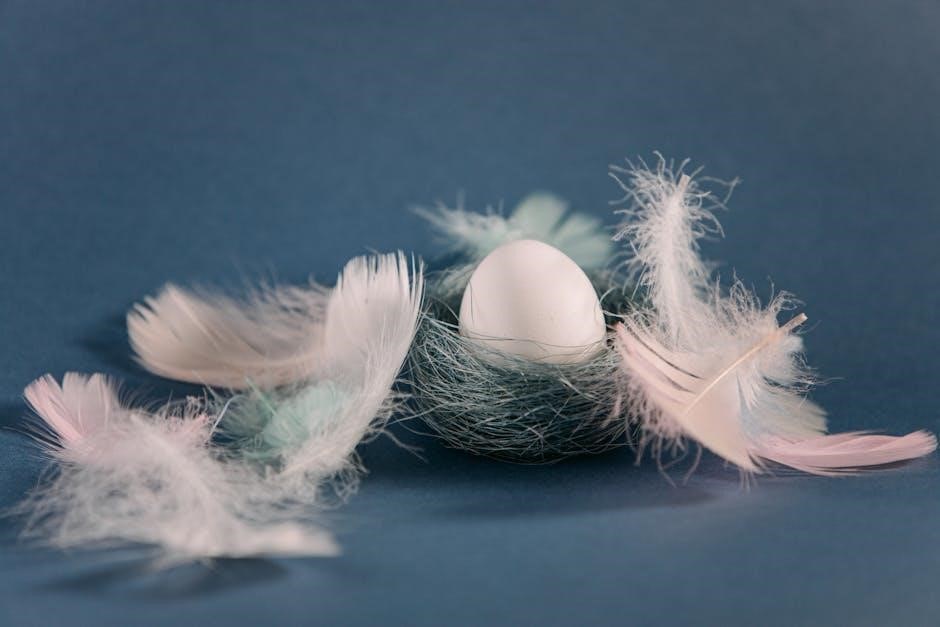cuckoo’s nest pdf
One Flew Over the Cuckoo’s Nest: An Analysis
Ken Kesey’s novel‚ published on the cusp of a decade of insanity‚ advances the theory that the sane were really insane. Explore a full book summary and in-depth character analysis of Randle P. McMurphy.
Overview of “One Flew Over the Cuckoo’s Nest”
Ken Kesey’s “One Flew Over the Cuckoo’s Nest‚” a sensation‚ explores the clash between Nurse Ratched and Randle McMurphy. The novel‚ published on the cusp of insanity‚ suggests the sane were insane. The narrator‚ Chief Bromden‚ pretends to be deaf and dumb.

The story unveils the horrors of the hospital and Nurse Ratched. The main theme is oppression. McMurphy shows respect for patients by shaking hands. The novel’s resolution shows the consequences of rebelling.
Kesey’s novel tells of the clash between wills‚ respectively‚ of Nurse Ratched and Randle Patrick McMurphy. One Flew Over the Cuckoos Nest Study Guide combines experiences. The project is an extension to Cuckoo Sandbox.
The novel advanced a theory that the sane were really insane. McMurphys continued refusal to follow protocol foreshadows rebellions. The novel suggests rebelling against oppressive forces. In-depth summary and analysis of every chapter available.
Explore the full book summary‚ an in-depth character analysis of Randle P. McMurphy‚ and explanations of important quotes from One Flew Over the Cuckoos Nest.
Character Analysis: Randle McMurphy
Randle McMurphy is a rebellious‚ charismatic figure who challenges the authority of Nurse Ratched. His refusal to follow protocol foreshadows greater rebellions. McMurphy shows unprecedented respect for the patients‚ shaking hands with them. He represents the rebellious will clashing with the repressive will of Nurse Ratched.
McMurphy’s arrival disrupts the established order of the mental hospital. He is a catalyst for change‚ encouraging the other patients to assert themselves. McMurphy’s defiance has devastating consequences. He embodies resistance against oppressive forces. His actions inspire others to question authority.
McMurphy’s character is central to the novel’s themes of freedom and individuality. He challenges the notion of sanity and conformity. McMurphy’s interactions with the patients highlight their humanity. His presence brings laughter and joy to the ward. He is a symbol of hope and rebellion.
Explore an in-depth character analysis of Randle P; McMurphy. He is the newest arrival challenging authority. He embodies resistance against oppressive forces. He shows respect for patients by shaking hands. McMurphy’s continued refusal to follow protocol foreshadows rebellions.
Character Analysis: Nurse Ratched
Nurse Ratched personifies authority and the establishment within the mental hospital. She represents the repressive forces that Ken Kesey explores in his novel. Her character is in direct conflict with Randle McMurphy‚ who embodies the rebellious will. She is a symbol of control and order‚ maintaining a strict regime within the ward.
Ratched’s methods of control are often subtle and manipulative; She uses psychological tactics to keep the patients submissive. Her power lies in her ability to undermine their self-esteem. Nurse Ratched represents the dangers of unchecked authority. She is portrayed as a cold and calculating figure.
Ratched’s character highlights the themes of oppression and rebellion. She is the antagonist to McMurphy’s protagonist. The clash between Ratched and McMurphy drives the narrative forward. She embodies the societal pressures to conform. Ratched’s character is a critique of institutional power.
In this movie we see Nurse Ratched‚ who personifies authority and establishment. Kesey relates the story of the clash between the repressive and rebellious wills. Nurse Ratched is challenged by the newest arrival. She maintains a strict regime within the ward. She uses psychological tactics to keep patients submissive.
Chief Bromden’s Role as Narrator
Chief Bromden serves as the narrator of “One Flew Over the Cuckoo’s Nest‚” providing a unique perspective on the events within the mental hospital. He pretends to be deaf and dumb to avoid attention‚ even though he is 1;8 meters tall. This allows him to observe the ward without being directly involved‚ giving the reader an insider’s view.
Bromden’s narration is not always reliable‚ as he experiences hallucinations and paranoia. His distorted perception of reality shapes the story‚ blurring the line between what is real and what is imagined. His narrative voice is crucial to understanding the themes of oppression and rebellion within the novel.
Chief’s perspective offers insight into the experiences of the patients and their struggles against Nurse Ratched’s control. His role as narrator adds depth and complexity to the story. He tells the reader about the horrors of the hospital; He speaks of Nurse Ratched and an individual named McMurphy.
Chief’s physical size contrasts with his perceived weakness. He sees the hospital and society as controlled by a “Combine.” His narration reveals the dehumanizing effects of institutionalization. He provides a voice for the marginalized and oppressed. His perspective highlights the subjective nature of reality.
Themes of Oppression and Rebellion
Oppression is a central theme in “One Flew Over the Cuckoo’s Nest.” The novel portrays the patients of the mental hospital as being subjected to the oppressive control of Nurse Ratched and the institution. Ratched embodies authority and establishment. The patients’ individuality is suppressed‚ and they are expected to conform to the rules and regulations of the ward.
Rebellion emerges as a response to this oppression. Randle McMurphy challenges Nurse Ratched’s authority. His refusal to follow protocol foreshadows his greater rebellions to come. McMurphy’s defiance inspires the other patients to question the system and assert their own identities. The novel explores the consequences of rebelling against oppressive forces.
The clash between Nurse Ratched and McMurphy represents the struggle between conformity and individuality. McMurphy shows unprecedented respect for all of the patients. This conflict highlights the dangers of unchecked power and the importance of resistance. The themes of oppression and rebellion are intertwined throughout the novel.
Kesey relates the story of the clash between the repressive and rebellious wills. The novel examines the psychological effects of oppression. It also shows the resilience of the human spirit in the face of adversity. The patients’ rebellion is a fight for their sanity and their freedom.
The Mental Hospital as a Symbol
In “One Flew Over the Cuckoo’s Nest‚” the mental hospital functions as a powerful symbol. It represents a microcosm of society‚ reflecting the oppressive forces and power dynamics that exist in the world at large. The hospital walls confine not only the patients but also their spirits‚ mirroring the constraints placed on individuals by societal norms and expectations.
The ward‚ with its strict rules and regimented routines‚ symbolizes the dehumanizing effects of institutional control. Nurse Ratched‚ as the head of the ward‚ embodies the oppressive power of the establishment‚ seeking to enforce conformity and suppress any form of rebellion. Her methods‚ often subtle and manipulative‚ highlight the insidious nature of control.
The patients within the hospital represent marginalized members of society‚ those deemed “different” or “deviant” by the prevailing standards. Their struggles for autonomy and self-expression mirror the broader fight for individual freedom against societal constraints. The hospital becomes a battleground where the forces of conformity and rebellion clash.
The mental hospital also symbolizes the fragility of the human mind and the potential for its manipulation. The patients’ vulnerabilities are exploited by the system‚ further emphasizing the dangers of unchecked power. The hospital serves as a stark reminder of the importance of protecting individual rights and resisting oppressive forces.
Ken Kesey’s “One Flew Over the Cuckoo’s Nest” unfolds within the walls of a mental institution‚ where the arrival of Randle McMurphy disrupts the established order. McMurphy‚ a rebellious and charismatic gambler‚ feigns insanity to avoid prison labor‚ but his presence ignites a spark of defiance among the patients;
The ward is ruled by the iron fist of Nurse Ratched‚ a manipulative and controlling figure who maintains order through subtle psychological tactics. McMurphy challenges her authority‚ encouraging the patients to question the system and reclaim their individuality. His antics‚ ranging from organizing fishing trips to challenging the ward’s rules‚ disrupt the monotonous routine and inspire hope.
As McMurphy’s influence grows‚ the patients begin to assert themselves‚ finding strength in their collective rebellion. They challenge Nurse Ratched’s control‚ demanding basic rights and expressing their desires. However‚ their newfound freedom comes at a cost‚ as Nurse Ratched retaliates with increasing force‚ employing isolation‚ medication‚ and other methods to suppress their defiance.
The conflict between McMurphy and Nurse Ratched escalates‚ culminating in a tragic climax. McMurphy’s unwavering spirit of rebellion inspires a profound transformation in Chief Bromden‚ a patient who has long pretended to be deaf and dumb. In the end‚ the novel explores the devastating consequences of rebelling against an oppressive system.
Analysis of Key Quotes
Key quotes in “One Flew Over the Cuckoo’s Nest” offer profound insights into the novel’s themes and characters. One significant quote‚ often attributed to Chief Bromden‚ highlights the oppressive atmosphere of the hospital: “They’re out there. Black Boys in white suits up there watching. They’re saying I ain’t crazy‚ I’m sane the same way they are.” This quote underscores the paranoia and the feeling of being constantly observed and judged within the institution.
McMurphy’s rebellious spirit is encapsulated in his defiant statement: “Man‚ when you lose your laugh‚ you lose your footing.” This quote emphasizes the importance of humor and joy as tools of resistance against oppressive forces. McMurphy’s laughter becomes a symbol of freedom and a challenge to Nurse Ratched’s control.

Nurse Ratched’s manipulative nature is revealed in her subtle yet controlling remarks. While not always explicitly stated‚ her actions and veiled threats convey her power. For instance‚ her seemingly innocent inquiries about the patients’ well-being often serve to reinforce their feelings of inadequacy and dependence.
Another crucial quote comes from Chief Bromden‚ reflecting on McMurphy’s impact: “He didn’t fight the system. He just went on being his own self.” This quote highlights the power of individuality and the importance of remaining true to oneself in the face of conformity and oppression. These quotes‚ among others‚ provide a deeper understanding of the novel’s complex themes.
The Novel’s Resolution and its Implications
The resolution of “One Flew Over the Cuckoo’s Nest” is both tragic and liberating‚ leaving a lasting impact on the reader. The novel’s resolution demonstrates the devastating consequences of rebelling against the system and the oppressive forces that control it.
McMurphy’s ultimate fate‚ following the lobotomy‚ serves as a stark reminder of the price of defiance. While his physical body is subdued‚ his spirit of rebellion lives on through Chief Bromden‚ who ultimately smothers McMurphy to prevent him from being a symbol of the institution’s power. This act is both an act of mercy and a final act of rebellion.
Chief Bromden’s subsequent escape from the hospital symbolizes the possibility of breaking free from the oppressive forces that seek to control individuals. By escaping‚ Chief reclaims his identity and freedom‚ carrying with him the memory of McMurphy’s courage and defiance. The resolution‚ despite its tragic elements‚ suggests that even in the face of overwhelming power‚ the human spirit can endure and ultimately triumph.
The implications of the novel’s resolution are far-reaching‚ prompting reflection on the nature of power‚ control‚ and the importance of individual freedom. It challenges readers to question societal norms and to resist conformity in the face of injustice.

McMurphy’s Defiance and its Consequences
Randle McMurphy’s arrival at the mental institution marks the beginning of a profound challenge to the established order. His defiance‚ a constant thread throughout the narrative‚ manifests in various forms‚ from small acts of rebellion to outright confrontations with Nurse Ratched.
McMurphy’s refusal to follow protocol foreshadows his greater rebellions to come. He shows unprecedented respect for all of the patients by shaking hands‚ immediately treating them as equals‚ something unheard of under Nurse Ratched’s regime. His infectious laughter and disregard for the rules disrupt the sterile‚ controlled environment of the ward‚ injecting a sense of chaos and unpredictability.
However‚ McMurphy’s defiance is not without its consequences. As he continues to challenge Nurse Ratched’s authority‚ the stakes are raised‚ and the repercussions become more severe. His initial acts of rebellion‚ such as gambling and organizing unauthorized activities‚ lead to punishments and increased surveillance.
Ultimately‚ McMurphy’s unwavering defiance leads to his tragic fate. His attempt to defend another patient results in a violent confrontation‚ leading to his lobotomization. While his spirit of rebellion inspires others‚ his physical and mental state is irrevocably altered‚ highlighting the devastating consequences of challenging a system determined to maintain control. McMurphy’s story serves as a cautionary tale about the price of defiance in the face of overwhelming power;
Ken Kesey’s Social Commentary
Ken Kesey’s “One Flew Over the Cuckoo’s Nest” serves as a powerful piece of social commentary‚ critiquing the conformity and oppressive institutions prevalent in mid-20th century America. The novel‚ published on the cusp of a decade of insanity‚ advances a novel theory: that the sane were really insane.
Through the microcosm of the mental institution‚ Kesey exposes the dehumanizing effects of institutional power and the dangers of unquestioning obedience. Nurse Ratched represents the stifling forces of societal control‚ enforcing rigid rules and suppressing individuality in the name of order and efficiency. The patients‚ initially subdued and compliant‚ embody the victims of a society that values conformity over self-expression.
Kesey critiques the medical establishment‚ portraying it as a tool for social control rather than a source of healing. The use of lobotomies and electroshock therapy highlights the brutal methods employed to silence dissent and maintain order. The novel also touches on the themes of masculinity and femininity‚ challenging traditional gender roles and exploring the consequences of suppressing natural instincts.
Furthermore‚ Kesey’s work reflects the countercultural movement of the 1960s‚ advocating for individual freedom‚ self-discovery‚ and rebellion against authority. McMurphy‚ the charismatic rebel‚ embodies the spirit of defiance and challenges the oppressive system‚ inspiring the other patients to reclaim their autonomy. “One Flew Over the Cuckoo’s Nest” remains a relevant and thought-provoking critique of societal norms and the importance of individual expression.
“One Flew Over the Cuckoo’s Nest” in Popular Culture
“One Flew Over the Cuckoo’s Nest” has had a profound and lasting impact on popular culture since its publication. Ken Kesey’s novel‚ exploring themes of oppression and rebellion‚ has resonated with audiences across various mediums‚ solidifying its place as a significant cultural touchstone.
The novel’s adaptation into a stage play and‚ most notably‚ a 1975 film starring Jack Nicholson‚ further amplified its reach. The film‚ which swept the Academy Awards‚ brought the story to a wider audience and cemented the characters of McMurphy and Nurse Ratched in the collective consciousness.
The film’s success led to numerous references and parodies in television shows‚ movies‚ and other forms of media. The image of Nurse Ratched‚ in particular‚ has become an iconic representation of authoritarian control and cold‚ calculated manipulation. The themes explored in the novel and film continue to be relevant in contemporary discussions about mental health‚ institutional power‚ and individual freedom.
The novel’s themes have inspired countless artists‚ musicians‚ and writers. The story of McMurphy’s defiance against the oppressive system serves as a powerful allegory for challenging societal norms and fighting for individual rights. “One Flew Over the Cuckoo’s Nest” remains a powerful and enduring work‚ sparking debate and influencing cultural discourse for generations.
